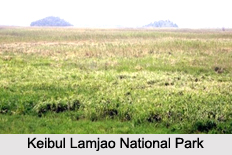 The state of Manipur is located in the north-eastern part of India. It"s geographical terrain is characterized by misty hills, valleys, cascading rapids, tripling rivers and forests, which have beautified this Jewel of India. These, along with varieties of flowers, exotic blooms, art forms, dances, indigenous games, martial arts, handloom clothes and exquisite handicrafts have the potential to draw tourists to this state. Manipur also has a national park called Keibul Lamjao National Park. This national park is described below.
The state of Manipur is located in the north-eastern part of India. It"s geographical terrain is characterized by misty hills, valleys, cascading rapids, tripling rivers and forests, which have beautified this Jewel of India. These, along with varieties of flowers, exotic blooms, art forms, dances, indigenous games, martial arts, handloom clothes and exquisite handicrafts have the potential to draw tourists to this state. Manipur also has a national park called Keibul Lamjao National Park. This national park is described below.
Keibul Lamjao National Park
Keibul Lamjao National Park is situated in the Bishnupur district. It was established on 28th of March, 1977. It is spread over an area of about 40 square kilometers. The park has a rich mixture of aquatic, wetland and terrestrial ecosystem. It is an important part of the Loktak Lake. A very unique characteristic of the park is that it is too deep to be marsh and too shallow to be a lake. It is characteristically a swamp with floating mass of vegetation. Phumdis have been estimated to occupy two third to three fourth of the total park area. The park area is blessed with Indian tropical monsoon. It receives an average annual rainfall of about 1,183 mm. Variance in temperature has been recorded in the park. Maximum temperature recorded in the park is 34.4 degree Celsius in summer, whereas the minimum temperature recorded is 1.7 degree Celsius in winter. The park has a water way which can be accessed by boats plying through the Loktak Lake to the Pabot Hill in the north, throughout the year.
Flora of Khibul Lamjao National Park
Apart from the floating decomposed plant materials called phumdis, some of the aquatic floral species found in Khibul Lamjao National Park are Zizania Latifolia (wild rice), Saccharum Munja (khoimom), S. Bengalensis, Eiranthus Procerus (singnang), Dioscorea Bulbifera (phumha), Cynodon Dactylon (tinthou) and Alpinia Galanga (pullei).
Fauna of Khibul Lamjao National Park
Some of the mammals recorded in the Khibul Lamjao National Park are large Indian civet (Viverra Civetta, Viverricula Indica), common otter (Lutra Lutra), fox, jungle cat, golden cat and bay bamboo rat. Some of the fishes recorded in the park include channa striata, channa punctatus, cyprinus carpio and wallago attu. This national park is also a home to amphibians and reptiles.



















